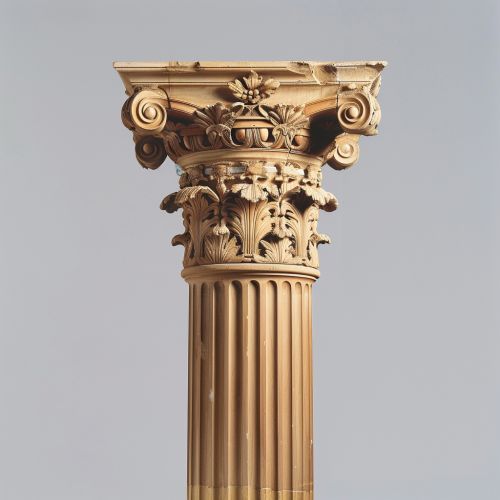Corinthian order
Introduction
The Corinthian order is one of the three principal classical orders of ancient Greek and Roman architecture. The other two are the Doric order which was the earliest, followed by the Ionic order. The Corinthian, with its offshoot the Composite, is the most ornate of the orders. This architectural style is characterized by slender fluted columns and elaborate capitals decorated with acanthus leaves and scrolls.


Origins and Development
The Corinthian order was named after the city of Corinth, where it is said to have originated, in the late 5th century BC. However, it did not become fully developed until the middle of the 4th century BC. The earliest known example of a Corinthian column is in the Temple of Apollo Epicurius at Bassae in Arcadia, c. 450–420 BC.
Characteristics
The Corinthian order is the most ornate of the Greek orders, characterized by a slender fluted column having an ornate capital decorated with two rows of acanthus leaves and four scrolls. It is also the most complex, with several parts such as the abacus, echinus, and the capital itself that are unique to the order.
Column
The column of the Corinthian order is typically ten diameters high, though as with all the orders these proportions could be adjusted for the requirements of the individual building. The shaft of the Corinthian order is fluted with 24 sharp-edged flutes, whereas the Doric column has 20 flutes that are rounded and less pronounced.
Capital
The capital is the most distinctive characteristic of the Corinthian order. It is composed of an upper and a lower cornice, which, although of different design, bear a close relationship to one another; the lower consists of a simple ring of acanthus leaves, the upper of a similar ring of palm leaves, both having a central rosette.
Entablature
The entablature of the Corinthian order is similar to that of the Ionic order, with a plain architrave, a frieze often containing sculptural decoration, and a cornice with dentils and a raking cornice. The Corinthian entablature often includes a frieze of figures in relief.
Use in Greek Architecture
Despite its late development in Greece, the Corinthian order was used extensively in Roman architecture. The Romans adapted the Corinthian order in many of their civic buildings, amphitheatres, and temples. The most famous example of a Corinthian column in Roman architecture is the Column of Marcus Aurelius in Rome, completed in AD 193.
Use in Roman Architecture
The Romans made several changes to the Corinthian order. It became the most popular order in the Roman Empire, especially in the cities of the eastern provinces. The Romans also added the Composite order, which combined the Corinthian order with the Ionic order. The Romans also used the Corinthian order in their military architecture, for example in the fortifications of the Roman frontier in Germany.
Influence on Later Architecture
The Corinthian order was revived in the Renaissance architecture, and has continued to be used in some modern architecture. It is seen in the United States in the Capitol Building in Washington, D.C., and the New York Stock Exchange Building in New York City. It is also used in the design of many modern buildings in Europe, such as the British Museum in London and the Louvre in Paris.
